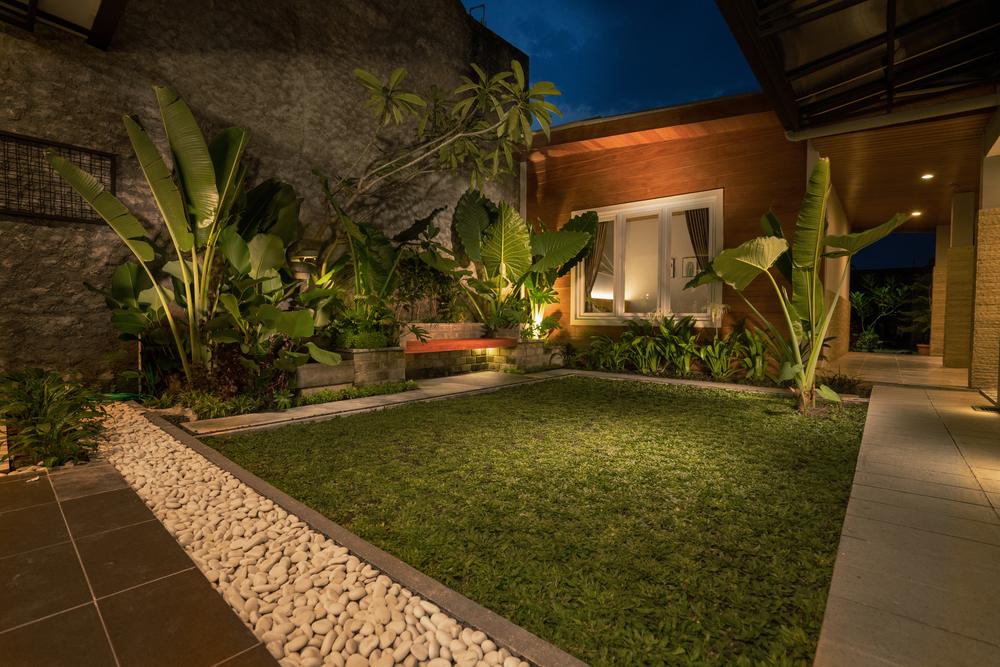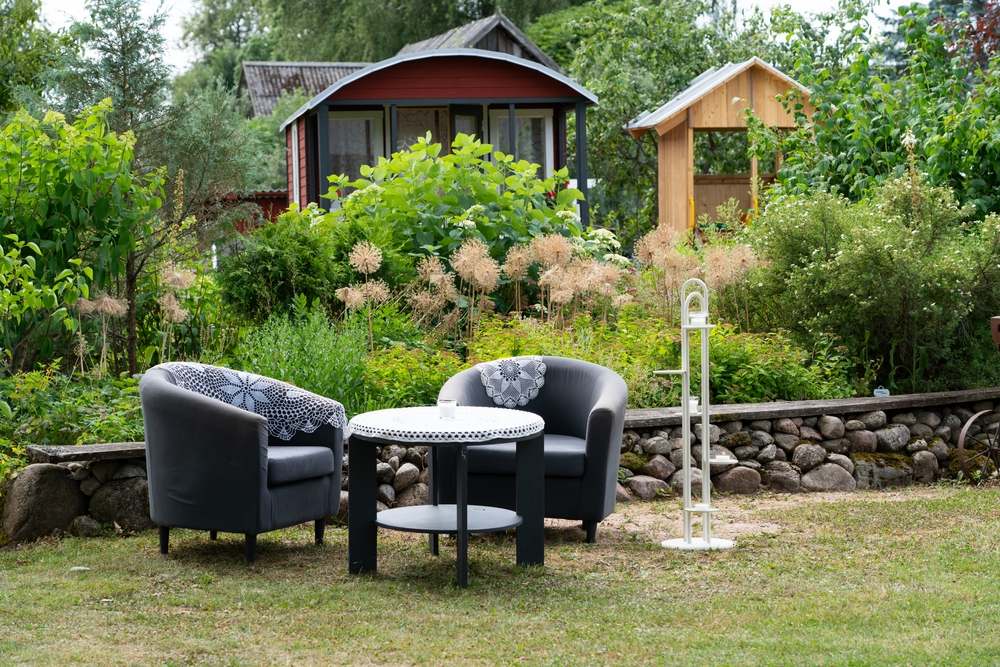
Backyard landscape design creates a practical and aesthetically pleasing outdoor living space. That means different for everyone, even if we design backyard landscaping similarly. Some may want a custom deck for hosting parties and picnics, while others may want a fun yard for kids to play in. No matter what you wish to achieve, this comprehensive guide can help you know how to design a backyard landscape.
After learning the basics and some important principles of design, you’ll be able to take all these backyard landscaping ideas and apply them to your own outdoor space. ALD is here to help you create the backyard of your dreams.
Before You Start
Before you design your backyard landscaping, spend a few hours in your backyard. Take a pen and paper to jot down important things you observe, or take pictures for reference. It’ll be like a site inventory.
Look at the space that you have with honest eyes and no judgment. If you’re realistic about things from the beginning, you’ll be able to avoid costly mistakes or having to redo backyard landscaping ideas. Ask yourself questions to promote deeper analysis:
- What’s the climate for your region?
- Do you want to focus on sustainable landscaping?
- What’s the topography of your yard?
- How does the sun hit each part of your outdoor space?
- Do you need to update your irrigation system?
- Who will use it?
It will also pay to take your time. If you can, spend an entire year observing your space before making major changes. Seeing your yard in each season gives you an excellent picture of its character and your needs for it.
Basic Design Concepts
These are a few basic concepts for how to design a backyard landscape. You’ll find that these backyard landscaping ideas are common throughout all art forms, whether painting, interior design, or photography.
Line
Lines can help us define an outdoor space. For example, if you have an ovular yard, you can plant a hedge in a line down the middle to help break the space into two separate areas. Never underestimate how visually powerful a line can be. They can make a space more visually interesting but also act as natural partitions.
Form
In a roundabout way, form is the shapes of the trees, plants, or walls you have in your outdoor space. We can determine the form of plants by the line, direction, and arrangement of their branches. The different plant form categories are:
- Horizontal and spreading
- Oval
- Vase
- Weeping
- Pyramidal
- Rounded
Knowing the forms will help you achieve unity, balance, and scale.
Texture
As it applies to plants, the texture is the relationship between the foliage, the twig size, and the plant’s mass. The textures that you see change with distance.
Color
You can use color in your landscape to evoke different moods and feelings.
If you don’t want to worry about the psychology of each color, you can at least keep in mind if a color is warm or cool. Cool colors give your backyard landscaping a restful and calm aura. Warm colors are cheerful and stimulating. Cool colors will also look good year-round, while warm colors look good during the spring and summer.
That’s why many people choose neutral colors when designing their hardscapes, like decks, walkways, and even fountains. Neutrals look appropriate in winter and summer, and you can use your planting to give pops of color as the seasons change. Bright purple and pink flowers look charming in warmer months, and you can switch to winter-friendly evergreens when temperatures drop.
If you’re looking to emphasize certain colors in your backyard, consider how outdoor lighting can add dimension and color to your space.
Principles of Landscape Design
Here are the major principles ALD uses when designing a backyard landscape. Remember that each one will relate to lines, form, texture, and color.
Unity
By definition, unity is undivided or unbroken completeness or totality, with nothing wanting. It organizes your view into orderly groups and allows emphasis for certain aspects. It helps you both create and link spaces together.
The trick when designing your outdoor space is to think of it as another room in your house. Yes, it should be unique, but it should also incorporate elements into its design that complement or continue the design of your house.
You can achieve this by using any of those four basic design concepts. If there are any strong lines or geometric shapes in your house’s architecture, add them to the backyard through pathways or sculptures.
If your house features stone, use stone for a pathway. If your roof is unique, use that color on an accent piece. The possibilities are endless.
Scale
There are two different ways to think about scale. An absolute scale is when you compare something’s size or value to a fixed structure, while a relative scale is when you compare things’ sizes or values to each other.
An example of absolute scale would be us comparing the size of everything in the yard to the size of the house. An example of a relative scale would be comparing a tree to a shrub. Both are useful, but you’ll want to focus more on the relative scale.
When describing relative scale, we can say something is high scale or low scale. High scale makes spaces feel smaller, while low scale creates peacefulness and relaxation.
Neither is superior to the other, but people do have preferences for one over the other. This is pertinent information to remember when designing, so you can tell the story you want to tell.
Balance
We can achieve balance in many ways. It doesn’t mean that one side of your yard is a mirror image of the other, but it can. Choose what works best for the landscape that you want to create.
So, we have both formal and informal balance. Formal balance is when you have a mirror image on both sides of your yard, while informal balance will have different things on the left and right sides, but neither side will feel lacking.
Formal balance may make you feel more comfortable and stable, while informal balance evokes curiosity and movement.
Simplicity
Sometimes, less is more. Simplicity in design means repetition instead of constantly changing elements. The key is to find a balance between simplicity and variety, as too much of either is unsightly.
While simplicity is a safer path to follow, your landscape will look boring or monotonous if you take it too far. For instance, a balance between simplicity and variety could be a row of shrubs with a tree behind them and off-center.
Variety
Variety is the opposite of simplicity in design. It’s a change or contrast in form, texture, and color, and it helps keep people engaged through stimulation. However, too much variety can be overwhelming, so use variety sparingly.
Emphasis
What is the focal point of your landscape? What elements are being emphasized or overpowered? nLike simplicity and variety, we want to maintain a balance in our yard when we emphasize things. The human eye looks for a dominating element; if it doesn’t see one, it’ll disengage. On the other hand, having too many dominating features will overwhelm the onlooker.
Here are a few easy ways to create emphasis:
- Give prominence to an ordinary object by putting a basket of fruit on a table.
- Use color by placing a bright red sculpture in the middle of some bushes.
- Use lines with a dirt path that draws your attention to a bench.
- Use diagonal lines to create a unique footpath in your flowerbed.
- Play with light by installing a spotlight or mirror.
You can create emphasis with lines, form, texture, or color. Don’t be afraid to get creative! Throw in something unusual or unexpected! Keep people guessing.
Sequence
Sequence is the change or flow that shows movement or life. You’ll find this in all four of our design elements. Texture is important because it changes with distance—for instance, the farther away, the finer looks.
When deciding which plants to place where you’ll want to keep your coarser plants closer to you and put the finer plants near the back. This is the most pleasing to the eye because that’s how it is in nature.
We also want to pay attention to sequences with color. Warm colors look pleasing when sequenced, but cool colors look better when used in contrast. With warm colors, you can place them in sequence from back to front or from the middle outwards.
You should start with the darkest shade and move to the lightest. Every time you change color, increase the number of plants you use by one-third. The darker a color is, the more it’ll dominate the scene, so you must balance that.
Start Your Landscaping Adventure With ALD

If you’re trying to decide how to design a backyard landscape, the team at ALD is here for you. We’re a do-it-all landscape design company and offer dozens of services, from excavation and grading to custom decks and waterscapes.
We are experts in designing backyard landscapes that are beautiful and functional. We specialize in front and back landscaping, landscape lighting, stone and rock design, and even landscape pool designs. No matter your backyard landscaping ideas, we are here to make your vision a reality. Contact ALD today to speak with one of our expert backyard landscapers!
